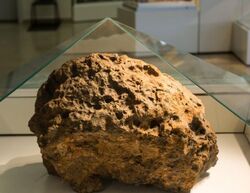| Chunk of the Chelyabinsk Meteor | |
|---|---|

| |
|
Origin |
Chelyabinsk Meteor |
|
Type |
Soccer ball-Sized Chunk of Rock |
|
Effects |
Creates a large sonic boom |
|
Downsides |
Effect |
|
Activation |
Throwing |
|
Collected by |
Agent Brady Brown |
|
Section |
|
|
Date of Collection |
Feb.21.2013 |
| [Source] | |
Origin[]
The Chelyabinsk meteor was a superbolide caused by a near-Earth asteroid that entered Earth's atmosphere over Russia on 15 February 2013 at about 09:20 YEKT (03:20 UTC), with a speed of 19.16 +/- 0.15 kilometres per second (60,000 - 69,000 km/h or 40,000 - 42,900 mph). It quickly became a brilliant superbolide meteor over the southern Ural region and was observed over a wide area of the region and in neighbouring republics. The light from the meteor was brighter than the Sun, even at 100 km distance and the resulting explosion released 20-30 times as much energy as the atomic bomb detonated at Hiroshima. Eyewitnesses felt intense heat from the fireball and the shock wave managed to shatter windows in an area a few tens of kilometers across.
Measuring about 20 metres in diameter, it is the largest known natural object to have entered Earth's atmosphere since the 1908 Tunguska event, which destroyed a wide, remote, forested area of Siberia. The Chelyabinsk meteor is also the only meteor confirmed to have resulted in a large number of injuries.
The earlier-predicted close approach of another, larger asteroid that same day, the roughly 30-metre 367943 Duende occurred about 16 hours later; the very different orbits of the two objects showed they were unrelated to each other.
On the first anniversary of this event, 15 February 2014, during the 2014 Winter Olympics in Sochi, in addition to their Olympic medals, the day's ten gold medalists were also given special commemorative medals which featured fragments of the Chelyabinsk meteorite.
Effect[]
When thrown, a large sonic boom will be produced, causing damage to objects in a 100 foot radius. The user will not be affected. The harder it is thrown, the more powerful the effect. It destroys all windows and glass within the blast radius, turning them into shrapnel which can cause bleeding and severe lacerations.
